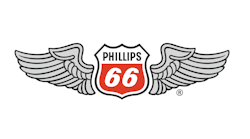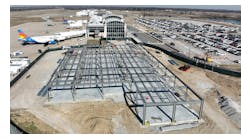The Responsibility of Q.C.
From the refinery to preflight, fuel must be continually monitored
By Vern Triebel, Quality Control Director, Phillips 66 Aviation
October 2000
Teaching safety and quality control measures reduces the odds against
the possibility of human error during aircraft
refueling, and helps FBO line managers to
reevaluate their own programs in the interest of safer operations.
Every act that moves a private aircraft
into the world of flight is the responsibility of the fixed base operator
(FBO), the fuel supplier, or the pilot. In the case of aviation fuel safety,
all three must take active steps to ensure quality control measures are
being taken at different points in the process.
Quality checks are imperative after the
fuel has been produced at the supplier’s terminal, when it is delivered
to the FBO, after it has been added to the FBO’s fuel tanks, and
of course, when it is pumped into an aircraft.
TAKING RESPONSIBILIT FOR QUALITY
To maintain consistent performance standards
with all refined fuels, oil companies supplying the general aviation market
strictly adhere to internal audits on fuel quality as well as work closely
with each of their FBO outlets to adhere to quality standards and promote
safety in handling fuels. This includes teams of experts who travel to
FBOs to inspect fueling equipment, test fuel quality, and reinforce with
FBO management the preventive maintenance and field testing steps necessary
to maintain safe fueling operations.
Often, the job of "line technician"
is an entry-level, high-turnover position. This means that in the sensitive
area of fueling, the person in charge of the fueling of a multimillion
dollar jet has a great deal of responsibility.
With this reality, the importance of ensuring
that FBOs are being supplied with clean, dry fuel, and that the fuel is
maintained properly on-site cannot be overstated.
Oil companies help FBOs manage this risk
by offering line training programs in the form of literature, videos,
and seminars, often free of charge. The responsibility for well-trained,
reliable line technicians, however, rests with the FBO. Line managers
and personnel need information to strengthen existing fuel quality control
programs, run safer operations, and reduce the possibility of human error
which can be a factor when it comes to a fueling mishap.
Take, for example, the FBO that accepted
a transport shipment of what was believed to be avgas even though the
line manager hadn’t scheduled a delivery. The transport driver was
told to off-load the fuel without anyone at the FBO first checking the
paperwork.
Once at the fuel farm, a line technician
also failed to check delivery paperwork before connecting the hose and
accepted the fuel without first doing a "clear and bright" white
bucket test.
Fortunately, the line manager arrived before
the first drop was pumped into the fuel farm. The line manager checked
the paperwork and discovered not only that the shipment was meant for
another FBO, but that it was jet fuel rather than 100LL avgas. Had the
paperwork been properly examined — or, failing that, had the white
bucket test been administered — the line technician would have known
immediately that something was wrong.
FBO TRAINING
At all Phillips 66 and many other FBOs,
line technicians must first complete a line technician training course
before handling or fueling aircraft. At many FBOs, video training programs
are offered, ranging in subjects from refueling piston and jet aircraft
to customer service and safety. After each video, line personnel take
written and hands-on tests. (At Phillips, upon passing all training segments,
technicians receive a "line service specialist" certification.)
A quality control and fire safety seminar
acts a refresher course to reinforce the basics learned during the video
training. For example, seminar attendees are reintroduced to the five
major tests that should be conducted at the FBO to ensure fuel quality.
They are:
The White Bucket Test — a visual test
to determine the possible presence of surfactants, water, and/or solids
in jet fuel. The fuel sample is taken from the filter vessel sump drains,
tank bottoms, and compartments of the transport truck when accepting fuel
and from the dispensing nozzle.
The Filter Membrane Test. The purpose of
the (colorimetric) test is to evaluate the performance of the filter/separator
(F/S) unit in removing particulate from the fuel. The F/S unit is the
major component for providing clean, dry jet fuel. If the F/S is performing
properly, the color rating method should indicate a reduction in rating
as compared to a sample taken before the F/S. For the line technician
this is a quantitative test — it indicates color in fuel and quantifies
if a high concentration of particulate is present. Further testing such
as a gravimetric test may be required.
Free (condensed) Water Test. "Dry"
fuel is a must for flight safety. The presence of condensed water in aviation
fuels can cause engine flameout or ice crystal formation. All tank and
filter sumps should be checked daily to determine if any free water is
present downstream of the Filter/Separator and if any free water found
should be sumped out. The free water test should include a check for undissolved
(or suspended) water using a test system similar to the Hydrokit.
API Gravity Test. Equally important to line
personnel is identifying if avgas is contaminated with other fuel. Each
fuel shipment to an FBO will have an API gravity value measured at the
terminal and listed on shipment receiving documents. If the API gravity
at the FBO differs from the API gravity record at the terminal, the shipment
may have been contaminated.
On proper handling of avgas, for example,
Phillips 66 explains that less than a half-gallon of jet fuel contamination
in a piston-engine fuel tank could be enough to bring an aircraft down.
Even worse, the engine will likely run well until after liftoff, since
it takes some time for the jet-A contaminant to move from the lowest point
in the sump through the fuel system to the cylinders.
Despite these potentially deadly consequences,
FBO line technicians may be unable to tell if avgas has been contaminated
with jet-A unless they conduct an API Gravity Test.
The Jet Fuel Additive Test. All Phillips
66 branded jet fuel is pre-blended with an additive package. The jet fuel
additive test determines whether the proper amount of additive is present
in the fuel.
AREAS OF CONCERN FOR LINE TECHNICIANS
Potential for Misfueling an Aircraft. Misfueling
an aircraft with jet fuel when it requires avgas, or vice versa, can happen.
The FAA requires that all jet-A hoses are fitted with a wide-mouth nozzle
(duck bill) to prevent line personnel from accidentally fueling piston
aircraft with jet fuel. The duck bill is wider than the mouth of any piston
aircraft fuel tank so it is nearly impossible to fuel one with it.
However, incidents have occurred as a result
of some helicopter refueling. After the line technician has fueled a helicopter
correctly with jet-A by taking the duck bill nozzle off (paradoxically,
the nozzle does not fit the fueling orifice of a helicopter — even
though it should), he or she can forget to put it back on, which could
lead to the subsequent misfueling of piston aircraft with jet fuel.
Properly Grounding The Aircraft When Refueling.
Grounding an aircraft to protect against static sparks should be a by-the-book
procedure. But fires have started when a line technician has taken off
the fueling nozzle clip because it’s a nuisance or it slows down
the jet plane refueling process.
The National Fire Prevention Association
(NFPA) and the FAA require that all overwing jet refueling use nozzle
grounding clips which can be attached to the plane or the fuel tank. This
avoids creating sparks which can lead to fires.
Proper Application of Anti-Icing Addi-tive.
Providing an aircraft with anti-icing protection is crucial to the aircraft
but can be completed impro-perly by the line technician when the FBO does
not use preblended fuel. In this case, the line technician must individually
blend the additive into the refueler. When administering the additive,
"splash blending", atomizing the additive with the fuel, or
spraying are methods not recommended since they are imprecise and can
render the anti-icing agent ineffective.
For best results, line technicians should
use an injector to meter out the additive in the proper proportions —
or use preblended fuel.
PILOT RESPONSIBILITY
Ultimately, it is the responsibility of
the pilot to ensure his aircraft has been safely and properly fueled.
Even though oil companies and FBOs spend a lot of effort and money ensuring
aviation fuel quality, it is the pilot who is the most important and final
link in the quality control chain.
Pilots are advised not to leave final responsibility
entirely with the line technician. Every pilot should watch the fueling
procedure to ensure it’s handled properly — and should sump
the tanks before taking off.
Tell-tale signs that an FBO has quality
fuel include: cleanliness of the facility and the fueling equipment; knowledgeable
line personnel; and branded fuel. An extremely low-priced fuel can be
a sign the pilot is not getting a quality product.
When all these steps are taken by the fuels
supplier, FBO and pilot, the risk of human error in aviation fueling is
drastically reduced and that means safer flying for everyone.
Detecting Microbial Growth - The ’X’ Inspection
Any fuel delivery system can become contaminated without pre-treated
fuel. Microbial build-up can rapidly occur inside refuelers and
may present a quality control problem. Microbial particles, already
saturated in the fuel, can flow into the closed environment of an
aircraft’s fuel tank. Once in the aircraft’s tanks, the
growth can continue unless the fuel is properly treated.
How can a line technician know if
the FBO’s fuel is contaminated with microbial growth? One suggestion
is to try an old military method called the "X" inspection.
A clean rag is tied to the bottom
of a pole to protect the inside of the tank and is then inserted,
rag-end first, into the refueler’s tank where the technician
"draws" an X into whatever sediment may exist at the bottom
of the tank. If the "X" mark remains visible through the
fuel after the pole has been removed, this an indication of heavy
microbial growth.





